
All lanes : Anti-CAPS1 antibody (ab32011) at 1 µg/mlLane 1 : Brain (Rat) Tissue Lysate Lane 2 : Brain (Mouse) Tissue Lysate Lane 3 : Heart (Mouse) Tissue Lysate Lane 4 : Brain (Rat) Tissue Lysate with CAPS1 peptide (ab32785) at 1 µg/mlLane 5 : Brain (Mouse) Tissue Lysate with CAPS1 peptide (ab32785) at 1 µg/mlLane 6 : Heart (Mouse) Tissue Lysate with CAPS1 peptide (ab32785) at 1 µg/mlLysates/proteins at 10 µg per lane.SecondaryIRDye 680 Conjugated Goat Anti-Rabbit IgG (H+L) at 1/10000 dilutionPerformed under reducing conditions.

ICC/IF image of ab32011 stained human SH-SY5Y cells. The cells were methanol fixed (5 min), permabilised in TBS-T (20 min) and incubated with the antibody (ab32011, 1µg/ml) for 1h at room temperature. 1%BSA / 10% normal goat serum / 0.3M glycine was used to quench autofluorescence and block non-specific protein-protein interactions. The secondary antibody (green) was Alexa Fluor® 488 goat anti-rabbit IgG (H+L) used at a 1/1000 dilution for 1h. Alexa Fluor® 594 WGA was used to label plasma membranes (red). DAPI was used to stain the cell nuclei (blue).

ab32011 staining CAPS1 in mouse brain tissue section by Immunohistochemistry (PFA perfusion fixed frozen sections). Tissue from 4% PFA perfused animals underwent overnight fixation in 4% paraformaldehyde, cryoprotected in 30% sucrose and cut using cryostat.The primary antibody was diluted, 1/300 (PBS + 0.3% Triton X100) and incubated with sample for 18 hours at 20°C. An abcam antibody ab60314, Chromeo 488 conjugated goat polyclonal to rabbit IgG, diluted 1/1000 was used as secondary.See Abreview


